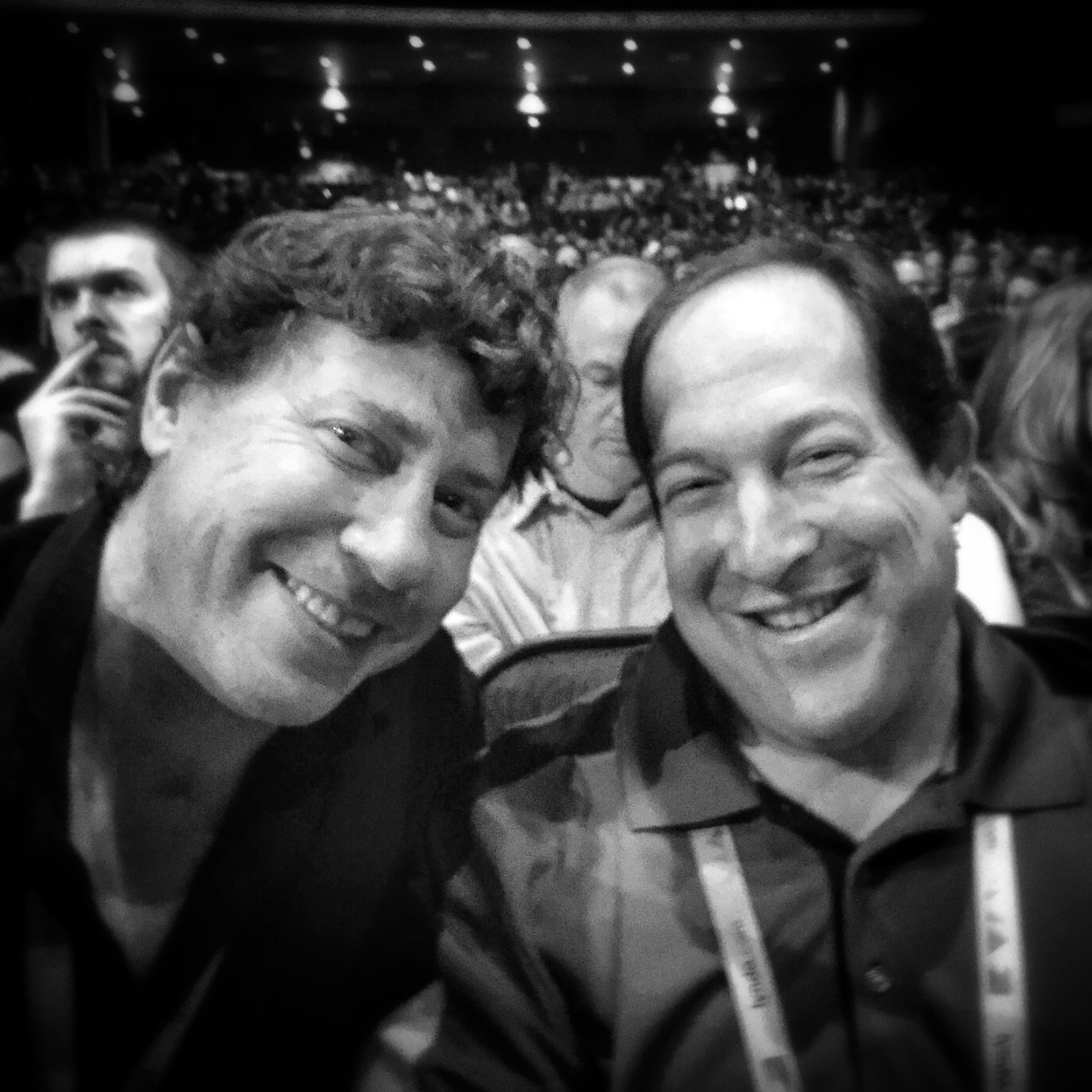New York Post Production Show
Every time I go to this show, I remember how much I miss NYC.
If you have a photo of me from the show, would you mind dropping it here?
I gave four talks:
- A boot camp on Compression
- Proxies and you in Adobe Premiere Pro
- A talk on VR Productions
- Secondaries in Adobe Premiere Pro
In both of the compression talks (boot camp + proxies), I've included my presets (and extras!) for you to use.
Additionally, not connected to any session is a "search folder" project that you can import into your own
Meanwhile, to get my notes you need to sign up for my very infrequent newsletter.
PostaPalooza 2015
I got the chance to go speak at PostaPalooza 2015 thanks to longtime friend Jem Scoenfeld of the C47 fame.
Do you have any photos of me? Boy, I'd sure like them. Click here to upload
Here are the sessions I spoke at, in order.
- Color Correction in FCPX
- The Timeline Index - FCPX secret weapon
- 20+ Avid tips
- Getting the most out of Adobe's New Color tools
- Bending Space and time in Adobe Premiere Pro
- h264 and Beyond.
By the way - I had some of the nicest conversations with the attendees. Really made it part of the experience for me!
(P.S. I made my deadline - before 3pm EST!)
Adobe Max 2015
Adobe Max is absolutely one of the best conferences I get a chance to go to. The people, the show floor, the event itself - amazing.
Here are the session notes:
- Thousands of Frames
- Avoid the Mistakes
- On the Cheap (plus 2 Premiere effect settings)
- Power Tips in Post
- Practical Video Compression in a Post Youtube World (plus several Media Encoder settings)
Yes, you can email me - yes, you can hire me too :D.
Oh, and if you have a picture of mine - either tag me on Facebook or email me directly - I'd love to have the picture!
UPDATE: Here is an upload link if you have a photo. It's good for about 1 week
FCPX Creative Summit
Absolutely a blast.
I saw a bunch of old friends and made a bunch of new ones. It doesn't get better than that.
I'll post some more later, but wanted to get my sessions posted ASAP.
In order:
- Switching to FCPX from FCP7 (or any other editor)
- Smarter Editing in FCPX
- Designing 4k Workflows
- Realistic Compression in a Post YouTube World
- Practical Compression: Getting the most out of Compressor
- Optimizing and Troubleshooting your editing system
Yes, feel free to reach out to say hi, ask questions. Please remember the next 2-3 weeks, it's key to review everything!
NAB is loads of fun, but loads of work.
NAB sessions
Given how many sessions I did - this is a quick posting of the notes (as they happen.)
Here are all the talks:
- Indepth Host and Sell your content
- Switchers Guide to Windows
- Designing a 4k edit system
- Maximizing Performance Optimizing Ppro for Win and Mac
- Maximizing Performance Optimizing Avid for Win and Mac
- Maximizing Performance Optimizing FCPX for Mac
- Compression workshop
- h.264 and Beyond
CabSat 2015
Dubai and CabSat!
Just a couple of pictures from my iPhone.
Always a great time being in Dubai. Saw some friends, made some new ones and had great sessions (due to the audience!)
If you'd like the sessions notes - here they are. And yes, you're allowed to email me and ask followup questions!
NAB 2013 Day 5 Practical Video Compression and FCPX tips
Last Day of NAB!
Practical Compression in a Post Youtube World session notes here.
Wait, where are the FCPX tips? It's always unique - Abba and I go in with no plan (beyond there being 4-5 tips we each want to do.) So, sadly, there isn't a way to give you the tips we covered.
But you have my email from this site; you can reach abba by going to NAB at ShapiroVideo dot com.
NAB 2013 Day 2 - Compression workshop - Updated!
Here are the zip files of the compression notes. One section (recipes) is still not updated yet - because I haven't figured out the best way to communicate the presets.
In the meantime (in order)
- Compression Basics
- Formats and Uses
- Recipes (not uploaded yet)
- Planning your compression
- Building a lab
- h264 and beyond
NAB 2013 Day 1: Compression Bootcamp
Bootcamp on Video compression.
Here are the key basics to understanding what happens and how to best compress video! We all do it, it's best we understand it!
Here are the notes! I got them online before I went to bed!
Watermark everything (Compression)
All to frequently, I see QuickTime Files called "Sequence 01.mov" or "Untitled Sequences.mov"
You know why this is bad right? Because you have no idea what that file is.
In the same way you should stay organized in your edit, you should name your sequences and watermark your work.
Being organized means no bins named "Stuff", "Misc.", "Other", or my favorite "Other Misc Stuff."
Naming your sequences means you can look at the file name and know what the sequence is meant for (Approval? Mastering? Client h.264 delivery?)
Watermarking your video helps your client understand what you're giving them. Every version except the final should have a watermark. It protects your work and helps your client know what it's meant for.
Compression Tips like this can be found by attending sessions at Post Production World at NAB (this link includes links to non-PPW sessions)
The difference in size when choosing VBR vs. CBR
The difference in file size has everything to do with data rates and nearly nothing to do with VBR or CBR compression settings.
VBR and CBR is about what type of analysis, if any is done to your file; Data rates are about file size.
Compression Tips like this can be found by attending sessions at Post Production World at NAB (this link includes links to non-PPW sessions)
Compression's Biggest enemy: Noise
Noise is your enemy.
The simplest concept in compression is the idea that you average four nearby pixels together - if they're really similar? You can replace them with one piece of data (rather than the original four.)
Noisy footage happens at the source for two reasons: poorly lit and a very compressed starting point (I'm looking at you DSLR h.264 files!). The worse the starting point, the more important it is to shoot right - else you have to deal with noise, meaning it'll be harder to compress your footage.
Make sure to view this in full. the noise on the left hand side makes this file far harder to compress.
Compression Tips like this can be found by attending sessions at Post Production World at NAB (this link includes links to non-PPW sessions)
Most compression tools have the ability to set I/O points
When you're testing and tweaking your compression tool of choice, you'll probably should test what you're doing rather than just running the settings on your entire file.
Did you know that most compression tools permit the setting of In/Out points (as a test for your video?)
Compression Tips like this can be found by attending sessions at Post Production World at NAB (this link includes links to non-PPW sessions)
Golden Rule of Compression
The Golden rule of Compression (above all others) is this:
Try to compress your video only once. Each time you compress your product, you're taking a chance and lowering it's final quality.
I keep seeing people use tools like Handbrake to rip a DVD into MPG4 and then use another tool, like Apple Compressor to make ProRes. That's taking a distribution quality codec (MPEG2) taking it to another distribution quality (h.264) and then to an editorial codec.
Try, when possible to only transform your video once - at the end of your editorial process.
Compression Tips like this can be found by attending sessions at Post Production World at NAB (this link includes links to non-PPW sessions)
Delivering for Now and the Future
Just a gratuitous picture of Cancun Paradise
My SlideDeck from the Editor's Retreat 2013 on Video Compression for Now and the Future
Way too much on Handbrake, iPad video Compression
I was answering a question over on CreativeCow about iPad Compression...
The poster is saying he's had odd problems with Handbrake and his iPad. And I thought it really belonged cleaned up and on my blog.
On Handbrake and other converters.
I use handbrake (but I also use a bunch of other tools.) It is important that you have the latest handbrake 0.9.8 and you update the presets (the gear at the bottom of the presets allows updating.) If you've been using handbrake for more than a year, one of two common errors are not picking the right preset or not having the preset updated.
Additionally, I've had success with some of the free converters from the Apple App Store (just search video convert.) Another strong free converter (cross platform just in case you're on windows) is the Miro Converter.
Most of the free converters (including handbrake) are generally using the same engine - ffmpeg. Handbrake was originally unique because it could decode DVD VOBs and get around copy protection. It's great, but there are gobs of other well done ffmpeg free converters.
The common Pro Converters (in alphabetical order) Adobe Media Encoder, Apple Compressor, Sorenson Squeeze and Telestream Episode, will absolutely work all the time - it's their product.
On iTunes sync
I've (personally) become a little frustrated on the pro video side with itunes; the sync process/time is at best annoying. I'm a fan of the third party players (like gPlayer, flex player, CineXPlayer) as I can add a video in the apps tab of itunes without having to sync the entire device. One, which I can't recall at the moment, will give you the option to use the hardware chip (or not).
Specific Apple guidelines
Apple has very specific guidelines for what your video has to be to work on the iPad (or other iOS devices.)
I dug up the specs from this webpage
Video formats supported:
- H.264 video up to 1080p, 30 frames per second, High Profile level 4.1 with AAC-LC audio up to 160 Kbps, 48kHz, stereo audio in .m4v, .mp4, and .mov file formats
- MPEG‑4 video up to 2.5 Mbps, 640 by 480 pixels, 30 frames per second, Simple Profile with AAC-LC audio up to 160 Kbps per channel, 48kHz, stereo audio in .m4v, .mp4, and .mov file format
- Motion JPEG (M-JPEG) up
to 35 Mbps, 1280 by 720 pixels, 30 frames per second, audio in ulaw, PCM
stereo audio in .avi file format
You probably will want the first one - the High Profile 4.1.
The
High profile part refers to a strict set of rules - necessary in this
case because there's a hardware decoder chip that allows playback (this
is similar to what all of these devices are using.)
The
High profile part refers to very strict ways the encoder is supposed to
work (what video space it uses, how b frames should be ordered)
The
4.1 part is the specific sizes, fps and data rate that it supports. It
does specifically 1080p and 720p. I didn't know till I looked that it
specifically does 2048x1024 - probably wasted on all of us anyway.
In conclusion
Yes, some non-broadcast standard sizes may work; other sizes aren't particularly well tested. I do know that if you conform to the specs, it's playable 100% of the time. You just need a good encoder with the right settings.
Understanding Video Compression
Supposedly Compression classes are supposed to be boring. I hope/think/want that our session wasn't. Great questions, fun session, lots of questions answered.
Session notes here
Precision Output from FCPX/Compressor
Apple really changed things (for the better) with the new sharing options in FCPX/Compressor.
I really, really like the bundle feature.
Don't forget to add watermarks to all your compression!
DMDC 2012 - Practical Video Compression in a Post Youtube World
Compression is always a favorite of mine to talk about....
Great talk, great people, great question.
Practical Video Compression in a Post YouTube World
It's one of my favorite sessions to present. It's a dark area with loads of misinformation. Every time I teach this, something is better in the presentation.














